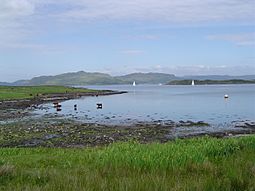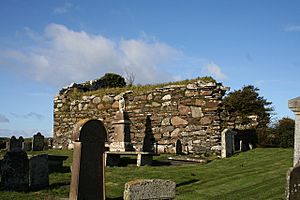Luing facts for kids
| Gaelic name | Luinn |
|---|---|
| Meaning of name | pre-Gaelic name of unclear meaning |
 View from near Toberonochy, Luing |
|
| OS grid reference | NM740100 |
| Coordinates | 56°13′42″N 5°38′28″W / 56.22829819°N 5.64124049°W |
| Physical geography | |
| Island group | Slate Islands |
| Area | 1,430 ha (5.5 sq mi) |
| Area rank | 40 |
| Highest elevation | Binneinn Furachail, 87 m (285 ft) |
| Administration | |
| Sovereign state | United Kingdom |
| Country | Scotland |
| Council area | Argyll and Bute |
| Demographics | |
| Population | 195 |
| Population density | 12.6/km2 (33/sq mi) |
| Largest settlement | Cullipool/Culapul |
Luing (in Gaelic: Luinn) is a small island in Scotland. It is part of the Slate Islands group. You can find it in the Firth of Lorn, which is west of Argyll. The island is about 16 miles (26 km) south of a town called Oban. Luing covers an area of about 1,430 hectares (5.5 square miles). It has a population of around 200 people. Most residents live in villages like Cullipool, Toberonochy, and Blackmillbay.
Contents
What is Luing Made Of?
The island of Luing is mostly made of a type of rock called Easdale Slate. This slate is very old, formed during a time called the Neoproterozoic era. You can also find thin layers of a rock called quartzite. In the northeast part of the island, there are areas with different kinds of rocks. These rocks were formed by intense heat deep underground.
Luing also has cracks in its bedrock. These cracks are filled with different types of rock, like basalt. These rock formations are from ancient times. Around the edges of the island, you can see old sand and gravel deposits. These show where the sea used to be many years ago.
Life and Work on Luing
Getting to Luing is easy! A regular ferry service connects Luing to the nearby island of Seil. The Cuan Sound, which the ferry crosses, is about 200 meters (660 feet) wide. Seil Island is then connected to the mainland by a bridge.
The main jobs on Luing today are tourism, lobster fishing, and beef farming. In the past, slate quarrying was very important. People dug for slate until 1965. There were slate quarries in Toberonochy, Cullipool, and Port Mary. Slate from Luing was used to build parts of the University of Glasgow. It also helped re-roof the famous Iona Abbey.
Luing is a small island, but it has produced many talented singers! Several people from Luing have won gold medals at the Mod. This is a big festival that celebrates Scottish Gaelic culture. Winners include Nan MacInnes in 1926, Sandy Brown in 1938, and Hughie MacQueen in 1985.
The Famous Luing Cattle
Luing cattle are a special type of cow that was first created on this island. They are a strong breed of red beef cattle. Farmers developed them to be tough enough to live in bad weather. The Cadzow family created this breed in 1947. They crossed two other types of cows: the Beef Shorthorn and the Highland cattle.
What Does the Name "Luing" Mean?
The name "Luing" might come from an old language called Old Norse. In Old Norse, lyng means "heather," and long means "ship." However, some experts believe it's an even older name. They think it might be a "pre-Gaelic" name, which means it was used before the Gaelic language arrived. The exact meaning of this older name is not clear.
A Look Back at Luing's History
Long ago, in the early Christian era, Luing was part of a Gaelic kingdom called Dál Riata. This kingdom was very important in early Scottish history.
Later, from the 800s to the 1200s, many islands in the Hebrides were controlled by Norse settlers. These islands became part of the Kingdom of the Isles. However, in 1098, a Scottish king named Edgar of Scotland made a deal with a Norse king, Magnus Barefoot. In this deal, Luing and another island called Lismore stayed under Scottish control.
The graveyard at the ruined Kilchattan Church tells stories of people who lived on Luing. You can see gravestones of quarry workers, sailors, and farmers. One notable gravestone belongs to Alexander Campbell, who was a Covenanter.
See also
 In Spanish: Luing para niños
In Spanish: Luing para niños


